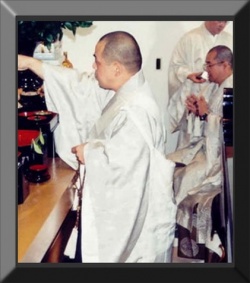Four Small Beads - Four bodhisattva characteristics leading to Buddhahood
by David Heimburg
If you look among the 108 beads in the main loop you'll see four different sized and sometimes different colored beads. These four beads represent the four leaders of the bodhisattvas of the earth. These bodhisattvas represent characteristics that you acquire as a result of chanting and teaching Namu-Myoho-Renge-Kyo. In the "Emerging from the Earth" (fifteenth) chapter of the Lotus Sutra, Shakyamuni tells a story about the earth splitting open and bodhisattvas in countless numbers coming forth. Their bodies are golden and they possess the thirty-two features that characterize a Buddha. They are led by four bodhisattvas - Superior Practices, Boundless Practices, Pure Practices, Firmly Established Practices - and Superior Practices is the leader of them all. This analogy was used to indicate the bodhisattva practice of compassion that directly leads to Buddhahood.
As an aside, it's interesting to note that the question as to where these four bodhisattvas came from and who they are led straight to the "Life Span" chapter, considered to be the heart of the Lotus Sutra and a description of enlightenment. In other words, even in the construct of the text of the Lotus Sutra, the four bodhisattvas led the way to the highest stage of enlightenment.
The four bodhisattva leaders signify the Buddha conditions or virtues of (1) true self, (2) eternity, (3) purity, and (4) happiness.
These four bodhisattvas, or aspects of Buddhahood, are associated explicitly with the Lotus Sutra, and more specifically with the teaching of Namu-Myoho-Renge-Kyo. These four bodhisattvas are said to be so much superior to the bodhisattvas associated with other Buddhist teachings that the other bodhisattvas, although seemingly magnificent and wonderful in isolation, pale by comparison to Superior Practices, Boundless Practices, Pure Practices, and Firmly Established Practices. Nichiren likens the comparison to a scene in which humble mountain folk are seen mingling with nobles or humble fishermen appear in an audience before the emperor. Such a statement is obviously intended to suggest the superiority of the results attained from a Buddhist practice based on these four principles.
True self, eternity, purity, and happiness are both the leaders of all people to the enlightenment of the Lotus Sutra as well as descriptions of the kind of enlightenment attained by this practice. We can use them as guides for our desired state of mind as we chant - in other words, objects of focus.
True self refers to the Buddha nature within, the Buddha you. Eternity refers to the eternal aspect of the Buddha nature inherent within all things and the eternal aspect of yourself. In essence, it means that all things have the potential to become Buddhas or lead others to enlightenment. This potential lies eternally dormant, in potentia, throughout the whole of the universe (or universes). As one cannot be totally fulfilled and happy while others suffer, Buddhas don't exist outside of their struggle to lead others to enlightenment.
In practice, all four bodhisattvas are related to compassion. After all, they are all bodhisattvas, representatives of the life condition of bodhisattva, the internal condition of compassion.
Superior Practices can be said to symbolize the unswerving determination to save all others from suffering. It is a self-confidence grounded in compassion that leads all others to Buddhahood. In his writings, Nichiren refers to himself as Bodhisattva Superior Practices incarnate.
Boundless Practices relates to the enduring life condition of Buddhahood which results from a vow and commitment to the bodhisattva practice of compassion. Pure Practices describes the process of purification that results from devoting oneself to the bodhisattva practice of compassion for all species, and indeed all living beings. When we internalize the reality that we are an aspect of the universe, as one's view of "self" expands to incorporate all of the natural world, caring and concern for others progresses to include more and more individuals of various species. The life condition that results is thereby purified to include a broader and broader definition of self. Conversely, being only concerned about selfish desires pollutes the flow of one's practice and leads to stagnation. Firmly Established Practices describes the condition where happiness continuously arises within a person who devotes their entire life to establishing a compassionate bodhisattva practice.
The placement of the four bodhisattva beads among the 108 desires has important symbolism. If we are to effectively deal with our desires, we must develop other, freeing and noble, aspects of ourselves. As we chant, true self, eternity, purity and happiness naturally surface and give rise to the development of caring and compassion for others. This is the place where your hands touch together. This is where the action is. Knowing theoretically that the fusing of subjective wisdom and objective reality leads to Buddhahood is not the same as actualizing or realizing it. In order to realize Buddhahood one must commit to the attainment of these four aspects of our lives and become more compassionate by means of a bodhisattva practice. There is no need to isolate oneself from others or even from our own desires. The four bodhisattva characteristics, as symbolized by the four small beads, remind us that we need to determinedly vow to put ultimate meaning and significance into our own lives.
Ten Beads In A Loop - Signify the Ten Worlds
If you look at the left hand Many Treasures bead, the one with two long strands extending from it, you'll notice a small circle of ten beads. These ten beads symbolize the mutual possession of the Ten Worlds or ten life conditions that a person can exhibit at any given moment. This categorization of life condition is a component principle of three thousand realms in a single moment of life, which T'ien-t'ai (537-597) established in his work titled Great Concentration and Insight. The important aspect of this principle is that the World of Buddhahood or enlightenment, is found within the reality of our lives in the other nine Worlds, not somewhere separate. This is why the Ten Worlds bead circle appears on the left or "Objective Reality" side of the beads. The mutual possession of the Ten Worlds is also symbolized by the touching together of our ten fingers while using the beads.
Here is a brief explanation of the Ten Worlds. (1) The world of hell. Hell indicates a condition in which living itself is misery and suffering, and in which, devoid of all freedom, one's anger and rage become a source of further self-destruction. (2) The world of hunger. A condition governed by endless desire for such things as food, profit, pleasure, power, recognition, or fame, in which one is never truly satisfied. (3) The world of animality. It is a condition driven by instinct and lacking in reason, morality, or wisdom with which to control oneself. In this condition, one is ruled by the "law of the jungle," quivering in fear of the strong, but despising and preying upon those weaker than oneself. (4) The world of anger or animosity. It is characterized by persistent, though not necessarily overt, aggressiveness. It is a condition dominated by ego, in which excessive pride prevents one from revealing one's true self or seeing others as they really are. Compelled by the need to be superior to others or surpass them at any cost, one may pretend politeness and even flatter others while inwardly despising them. (5) The world of humanity. In this state, one tries to control one's desires and impulses with reason and act in harmony with one's surroundings and other people, while also aspiring for a higher state of life. (6) The world of rapture or sometimes called the world of heaven. This is a condition of contentment and joy that one feels when released from suffering or upon satisfaction of some desire. It is a temporary joy that is dependent upon and may easily change with circumstances. These six worlds are called the six paths. Beings in the six paths, or those who tend toward these states of life, are largely controlled by the restrictions of their surroundings and are therefore extremely vulnerable to changing circumstances. The remaining four states, in which one transcends the uncertainty of the six paths, are called the four noble worlds: (7) The world of learning. In this state, one dedicates oneself to creating a better life through self-reformation and self-development by learning from the ideas, knowledge, and experience of one's predecessors and contemporaries. (8) The world of realization. In this condition one perceives the impermanence of all phenomena and strives to fee oneself from the sufferings of the six paths by seeing some lasting truth through one's own observations and effort. People in the worlds of learning and realization are given more to the pursuit of self-perfection than to altruism. (9) The world of bodhisattva is a state of compassion in which one thinks of and works for others' happiness even before becoming happy oneself. The term bodhisattva consists of bodhi (enlightenment) and sattva (beings), meaning a person who seeks enlightenment while leading others to enlightenment. The condition of bodhisattva is an awareness that the way to self-perfection lies only in altruism, working for the enlightenment of others even before their own enlightenment. (10) The world of Buddhahood is characterized as a state of perfect and absolute freedom in which one realizes the true aspect of all phenomena or the true nature of life. One can achieve this state by manifesting the Buddha nature inherent in one's life. Attaining this condition does not mean becoming a special being, separate from the other conditions of life. Mutual possession of the ten worlds indicates that within each of the other nine worlds the world of Buddhahood, or tenth world, can manifest itself. In this state one still continues to work against and defeat the negative functions of life and transform any and all difficulties into causes for further development. It is a state of complete access to the boundless wisdom, compassion, courage, and other qualities inherent in life; with these one can create harmony with and among others and between human life and nature.



